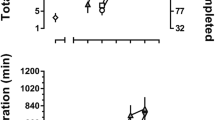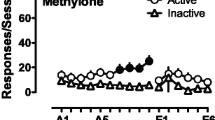Abstract.
Rationale: The reinforcing effects of MDMA and its enantiomers have not been extensively characterized in laboratory animals. Objectives: To investigate whether MDMA and its stereoisomers would be self-administered intravenously by rhesus monkeys (Macaca mulatta), and to assess the effects of serotonin2 receptor antagonists on MDMA-maintained responding. Methods: Four adult male rhesus monkeys were maintained on a fixed ratio 10, time-out 60-s schedule for 0.01 mg/kg cocaine or saline injections. Racemic MDMA and its stereoisomers, and racemic methamphetamine were periodically substituted for cocaine or saline. In subsequent antagonist experiments, five adult rhesus monkeys (three male, two female) were maintained on a multiple dose fixed ratio 30, time-out 45-s schedule for cocaine or saline injections. Racemic MDMA and its enantiomers were periodically substituted for cocaine or saline, with or without a pre-session injection of the serotonin2 receptor antagonists ketanserin or MDL100907. Results: In the initial self-administration experiments, MDMA and its stereoisomers generated "inverted U"-shaped self-administration curves across the dose range tested. Racemic MDMA doses between 0.01 and 0.1 mg/kg per injection, S(+)-MDMA doses between 0.003 and 0.1 mg/kg per injection, and R(–)-MDMA doses between 0.01 and 0.1 mg/kg per injection engendered more responding than saline; however, no dose of any form of MDMA maintained as much behavior as cocaine or methamphetamine. In subsequent antagonist experiments, pretreatments with 0.1 or 0.3 mg/kg ketanserin or MDL100907 attenuated responding for S(+)-MDMA, and completely abolished responding for R(–)-MDMA, but did not affect cocaine-maintained behavior. Conclusions: MDMA and its stereoisomers serve as reinforcers in rhesus monkeys. We suggest that stimulation of 5-HT2A receptors is integral to the reinforcing effects of MDMA.
Similar content being viewed by others
Author information
Authors and Affiliations
Additional information
Electronic Publication
Rights and permissions
About this article
Cite this article
Fantegrossi, W.E., Ullrich, T., Rice, K.C. et al. 3,4-Methylenedioxymethamphetamine (MDMA, "ecstasy") and its stereoisomers as reinforcers in rhesus monkeys: serotonergic involvement. Psychopharmacology 161, 356–364 (2002). https://doi.org/10.1007/s00213-002-1021-6
Received:
Accepted:
Issue Date:
DOI: https://doi.org/10.1007/s00213-002-1021-6




